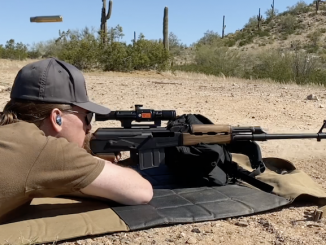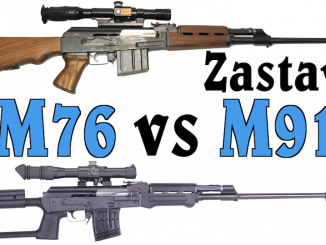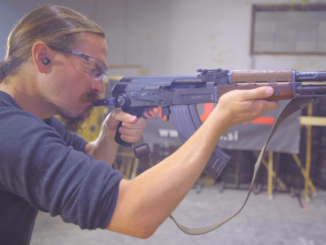Lazar Yovanovitch was a Serbian native of Yugoslavia, born in Belgrade. He left engineering school to design firearms, and developed a couple .22 and .380 caliber pistols. None were adopted by the Yugoslav military, but he did use his .380 in international competition at the 1933 ISSF 25m rapid fire competition and the 1936 Berlin Olympics.
Yovanovitch participated briefly in WWII as a petty officer in a hydroplane squadron, was captured by Italian forces, and then escaped into Switzerland in the lull between Italian surrender and German re-occpation of his POW camp. After the war he emigrated to Canada, where he made one last example of his Model 1931 .380 pistol, for his own use and enjoyment.




Mr.Yovanovitch should be an admirer of Old Sauer M13 pistols.
Trully an interesting and unique story . Is there a fotograph of Lazar ??
Mr. Yovanovitch should be an admirer of Sauer Old M13 pistols. More about inventor and his guns here;http://www.smallarmsreview.com/display.article.cfm?idarticles=1589
I think Yovanovitch answered question which were never asked (Yugoslavia just had FN 1910/22 automatic pistols)
On the right side of the smallarmsreview-article there is a gallery which also shows a photograph of Mr. Jovanovich.
Three photographs actually.
Thank you for the info Claus .
Whilst there may be nothing spectacular or especially infinitive about this pistol it certainly looks cool and would I think be competitive with other designs of the time.
Gent is in Belgium not in The Netherlands. Nice looking gun.
Can’t find information on the Pre-WW2 Anschutz pistol he designed. M Maxberry
The only time I ever saw a reference to this pistol was in a book called “Service Handguns – A Collector’s guide” by Klaus-Peter Koenig and Martin Hugo.
I do not think it is the same pistol, because it is described as being manufactured by Voiko Tekhnikki Zavod, which sounds Yugoslavian to me, and looking closely at the photograph it appears to have the serial number 11 on the mag release, whereas our example is, oddly enough, number 7. However, the barrel is clearly marked “FN”, so it seems that Yovanovitch may have used FN 1910/22 barrels for convenience in all his prototypes, which makes sense when you think about it. So it appears there may be two of these pistols in existence.
Incidentally, the book for some strange reason gives the calibre as “9mm Browning”, not .380 acp, which is odd. It led me to think it might have been chambered for 9mm Browning Long.
JohnK, 9mm Browning was one of domestic names in Yugoslavia for .380 acp. Just like “9mm kratki” or “kratka devetka” meaning “short nine”. 9mm Luger was and still is known as “9mm dugi” or 9mm Long.
There was V.T.Z. M.33 pistol which was rearsenaled 7-shot Ruby variant. One was on sale on RIA few auctions ago.
Those were NOT new-built guns, they used original Spanish parts, with all markings ground off, re-blued, all springs replaced, and standardized as much as possible.
As a general rule, without further qualifiers “9mm Browning” means .380 ACP in Europe. 9mm Browning Long was a short-lived cartridge with limited popularity, so many people started to omit the “Short/Kurtz/Court” etc. in colloquial language when referring to the .380 ACP. Of course in a serious written text one should always use more exact terminology, so it’s still an odd mistake by the authors of the book.
Nice to hear more context in this Rock island series Ian, This and the Japanese semi auto rifle trials. Interesting counter point to the Chinese mystery pistols, made by some guy with access to tools…
Simply put, I am delighted with this story. Presenter is well versed with narrative and does masterful job, which had become a standard at this web. Congratulation!
As far as pistol itself this is exactly what .380cal should be. Simple, elegant, almost in style of art-nouveau. To compare with other pistols of the time period, this is elegant and straight-forward common sense design. Also, it looks simple to manufacture.
If anything offers itself as a side thought it may be possible addition of integral sound attenuator into front portion of slide.
Right to the point Denny . Kudos from Greece .
Thank you Makis. It is great to have such an international exchange with people of same inclination.
Just to further the cause of being geo-historically picky (see Ghent above), nobody was born in Belgrade, Yugoslavia, in 1898 because there was no such country as Yugoslavia until 1919. He was born in Belgrade, Serbia, Austria-Hungary, in what would become Yugoslavia. If he reached age 18 during WW I, I’m surprised he was not conscripted for that war.
Serbia was never part of Austria Hungary, but it was occupied by them in 1915. Their decimated army retreated to Greece, so probably thats the reason he was not conscripted